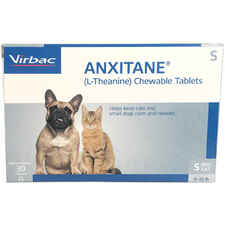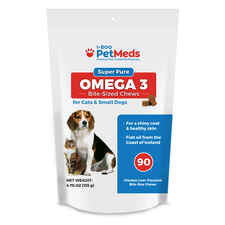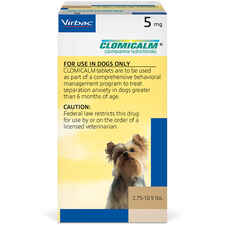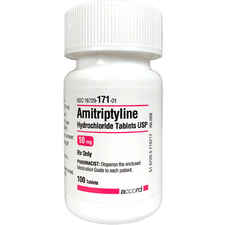Separation Anxiety Treatment for Dogs and Cats
Doctor of Veterinary Medicine

While efforts are made to answer all questions as quickly as possible, if an immediate answer is required or if your pet is in need of urgent or emergency care, contact your pet's veterinarian immediately.
Doctor of Veterinary Medicine

You will receive an answer from Dr. Lindsay and our vet/tech team as soon as possible, usually the same day.
All answers are provided for informational or educational purposes only, and are intended to be a supplement to, and not a substitute for, the expertise and professional judgment of your pet's veterinarian.
It may be necessary to consult your pet's veterinarian regarding the applicability of any opinions or recommendations with respect to your pet's symptoms or medical condition.
CloseDoctor of Veterinary Medicine

An error has occurred, please reload the page and try again.
CloseWhile efforts are made to answer all questions as quickly as possible, if an immediate answer is required or if your pet is in need of urgent or emergency care, contact your pet's veterinarian immediately.
There is no answer related to your question
Treatment options for pets with separation anxiety
Treating pet separation anxiety requires you to desensitize your pet so your pet is no longer anxious as you come and go. Desensitizing requires you to start with behaviors that don't cause anxiety and gradually progress to behaviors that have caused anxiety in the past and you want your pet to accept. Adjust the rate you progress by how quickly your pet adapts. If anxiety occurs, stop what you're doing and go back to the step that did not upset your pet. Then, more gradually move toward the behavior you want your pet to accept. By taking a couple of months to desensitize your pet, you'll have the rest of your pet's life to enjoy having a pet that is relaxed as you come and go from your home.
To desensitize your pet to your leaving your home, repeat each of the following until your pet no longer takes any notice.
- From within your home, open the door and shut it without walking through.
- Open the door, walk through, shut the door, and immediately re-enter.
- Open the door, walk through, shut the door, and re-enter in 15 seconds.
- Open the door, walk through, shut the door, and re-enter in 30 seconds.
- Open the door, walk through, shut the door, and re-enter in one minute.
- Gradually increase time before re-entry until absence is tolerated for an hour, two hours, three hours, etc.
You're proceeding too quickly if your pet demonstrates anxiety at any step. Some pets require dozens of repetitions. Let your pet be your guide.
Non-prescription products that help pets feel less anxious
Thundershirt for dogs
The Thundershirt is an affordable, drug-free solution for anxiety problems in dogs. It uses gentle, constant pressure on your pet's torso (like a constant hug) to help calm your pet. Unlike many products for pet anxiety, Thundershirt does not contain any pheromones or drugs, so it helps calm your pet without making him or her lethargic. Thundershirt is also great for dogs with fear of thunder or fireworks (or any loud noise), travel anxiety, crate anxiety, barking problems, hyperactivity, leash pulling, and even as a general training tool.
Pheromones for separation anxiety in dogs and cats
Adaptil Collar for Dogs and Sentry Calming Collar for Dogs contain pheromones that mimic the pheromone that the mother dog produces to calm and reassure her puppies, which send the message that your dog is safe. Dogs smell this pheromone, but people cannot. This pheromone sends the same signal your dog got as a puppy snuggling with his or her mother.
The Sentry Calming Collar for Cats mimics the pheromone that the mother cat produces to calm and reassure her kittens. Cats can smell this pheromone, but people cannot. The Calming Collar for Cats works to mimic the natural way to help cats cope with fearful situations.
Herbs for separation anxiety in dogs and cats
Composure Liquid MAX is a calming herbal liquid made with thiamine (vitamin B1), L-theanine, lecithin, and calming decapeptide from milk protein.
Quiet Moments (for dogs) is a calming herbal tablet containing chamomile flower, passion flower, thiamine, ginger, and L-tryptophan.
Homeopathic remedies for separation anxiety in dogs and cats
HomeoPet Anxiety Relief is a homeopathic remedy with chamomile, valeriana, ignatia, and other ingredients. Individual homeopathic remedies used for separation anxiety include phosphorus, lachesis, phosphoric acid, lycopodium, pulsatilla, arsenicum, argentum nitricum, and kali carbonicum. Your holistic veterinarian will help you find the best remedy based on your pet's physical and emotional characteristics.
Omega 3 fatty acids might also help with separation anxiety in dogs and cats
Omega 3 fatty acids promote brain nutrition, learning, good mood, and good behavior.
Give your pet toys to help with separation anxiety
Toys that slowly release food can keep pets busy. Kong toys hold food—peanut butter, cheese, kibble—and can keep your pet focused on something other than your absence.
Crating pets with separation anxiety
Crating will help some pets and upset others. Provide a crate for your pet if it makes your pet calm, but don't use a crate if it makes your pet anxious. If you can't lock your pet in a crate to prevent him or her from being destructive when you're not home, use herbs, homeopathics, and pheromones, or get a prescription medication from your veterinarian. Pets that are anxious can't learn, and you want your pet to learn to be calm.
Allowing your pet to see out the window when you're not home
Some pets are more at ease if they can see the outside world. These pets should have access to window perches and doors that allow them to see outside. Other pets are easily upset by wandering cats and dogs and become more anxious if they can see them in the yard. These pets should not be able to see outdoors.
Some cats begin marking (spraying) inside the house in frustration because they see stray cats wandering in the yard. If your cat does this, close the curtains and don't let him or her see outside. Also, try to discourage the stray cats.
Prescription products that help control pet anxiety
Prescription pharmaceuticals prescribed for pets with separation anxiety include Amitriptyline, Clomicalm (for dogs), Clomipramine, Fluoxetine, Diazepam, Alprazolam, Triazolam, Cyproheptadine, and Buspirone.
Prescription pharmaceuticals don't begin to produce results until they've been taken for days or weeks. Prescription anxiolytics should be continued for a minimum of 1-2 months after your pet stops feeling anxious. In the average pet, treatment lasts 4-6 months. Pets are slowly weaned off these medications.
Eliminate barbering in cats (psychogenic grooming)
Treatment for barbering in cats requires a veterinary consultation to determine the cause. Your veterinarian may suggest homeopathic medications, such as HomeoPet Anxiety Relief, or prescription medications, such as Amitriptyline, Clomicalm, Clomipramine, Fluoxetine, Diazepam, Alprazolam, and Buspirone. Your veterinarian will also encourage you to keep your cat flea-free, and may recommend flea preventatives.
Try using more than one behavior-modifying product
The pheromones in Adaptil Collar for Dogs and Sentry Calming Collar for Cats can be combined with herbal medications and Omega 3 fatty acids. Combining behavior-modifying agents is like tuning up a car engine. The mechanic makes the car operate best by providing brake fluid, transmission fluid, engine oil, radiator fluid, and steering fluid. These fluids all work in different ways to make the engine function optimally. In the same way, behavior-modifying agents all work in different ways to promote brain and organ health so that your pet is happy and well-behaved.
If you plan to board your pet at a kennel
If your pet will be boarded, prepare him or her with short pleasant stays at the same place. Provide the boarding establishment with the calming pheromones Adaptil Collar for Dogs and Sentry Calming Collar for Cats because they can help relax your pet. Provide calming herbs, such as Composure Liquid MAX or Quiet Moments (for dogs), and arrange for your pet to have plenty of exercise and human interaction. If possible, also make sure your pet has plenty of his or her favorite toys and items such as clothes or blankets that contain your scent.
Change your behavior
Unfortunately, many pet owners do not realize that their own behavior is actually making their pet's separation anxiety symptoms worse. Sometimes, curing your pet of separation anxiety requires you to change your habits as well. Below are a couple of frequently asked questions about separation anxiety in dogs and cats.
"Can't I just cuddle my pet to make him or her less anxious?"
No. Cuddling doesn't cure anxiety and unfortunately, this is often our first tendency. The problem with cuddling an anxious pet is that your are teaching your pet he or she will get rewarded when anxious. What you want to reward is calm happiness. If you want separation anxiety to cease, it is better to ask your pet to sit or come, and reward him or her for proper behavior, than to soothe your pet when he or she is anxious.
"I am excited to see my pet when I get home and make a big deal of it—am I increasing the likelihood my pet will develop separation anxiety?"
Unfortunately, yes. Most pets with separation anxiety are very excited when their owner returns, so your pet's greeting behavior may be excessively exuberant. Often we mistakenly encourage this behavior because we believe it means our pet loves us deeply. Unfortunately, encouraging exuberant greetings causes pets to become more anxious when we are away rather than to reassure pets that we will return. It is best to ignore your pet for a few minutes after returning home, and greet your pet when he or she is calm. This way, you are rewarding calm behavior.
"I feel guilty when I leave my pet in the morning and spend a lot of time telling him or her not to worry—am I increasing the likelihood that my pet will develop separation anxiety?"
Yes. Pets with separation anxiety follow us around, looking increasingly more despondent the closer we get to leaving. By the time we exit, our pets are anxious and the sympathetic (fight or flight) nervous system is aroused. The sympathetic system releases adrenalin, and adrenalin stimulates activity. Thus, pets with separation anxiety begin barking, yowling, destroying furniture, or defecating right after we leave. The most severe reaction occurs within 15 minutes of departure, but can persist the entire time we are away.
Act like nothing is happening while you prepare to leave. Exit calmly. Have nerves of steel for a short period and you will be able to turn things around. Also, sometimes it helps your pet if you want to leave a radio on or a TV playing. Just hearing sounds sometimes makes a difference.



























